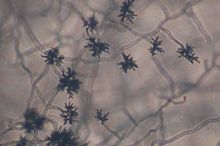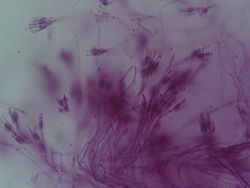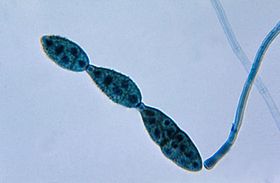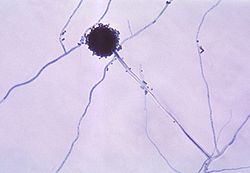- Cladosporium
 Cladosporium is a genus of fungi including some of the most common indoor and outdoor molds. Species produce olive-green to brown or black colonies, and have dark-pigmented conidia that are formed in simple or branching chains.
Cladosporium is a genus of fungi including some of the most common indoor and outdoor molds. Species produce olive-green to brown or black colonies, and have dark-pigmented conidia that are formed in simple or branching chains.
The many species of Cladosporium are commonly found on living and dead plant material. Some species are plant pathogens, others parasitize other fungi. Cladosporium spores are wind-dispersed and they are often extremely abundant in outdoor air. Indoors Cladosporium species may grow on surfaces when moisture is present.
Cladosporium fulvum, cause of tomato leaf mould, has been an important genetic model, in that the genetics of host resistance are understood.
- Penicillium
 Penicillium is a genus of ascomycetous fungi of major importance in the natural environment as well as food and drug production.
Penicillium is a genus of ascomycetous fungi of major importance in the natural environment as well as food and drug production.
Members of the genus produce penicillin, a molecule that is used as an antibiotic, which kills or stops the growth of certain kinds of bacteria inside the body. According to the Dictionary of the Fungi (10th edition, 2008), the widespread genus contains over 300 species.
- Alternaria
 Alternaria is a genus of ascomycete fungi. Alternaria species are known as major plant pathogens. They are also common allergens in humans, growing indoors and causing hay fever or hypersensitivity reactions that sometimes lead to asthma. They readily cause opportunistic infections in immunocompromised people such as AIDS patients.
Alternaria is a genus of ascomycete fungi. Alternaria species are known as major plant pathogens. They are also common allergens in humans, growing indoors and causing hay fever or hypersensitivity reactions that sometimes lead to asthma. They readily cause opportunistic infections in immunocompromised people such as AIDS patients.
There are 299 species in the genus;[1][2] they are ubiquitous in the environment and are a natural part of fungal flora almost everywhere. They are normal agents of decay and decomposition. The spores are airborne and found in the soil and water, as well as indoors and on objects. The club-shaped spores are single or form long chains. They can grow thick colonies which are usually green, black, or gray.[2]
At least 20% of agricultural spoilage is caused by Alternaria species; most severe losses may reach up to 80% of yield, though.[2] Many human health disorders can be caused by these fungi, which grow on skin and mucous membranes, including on the eyeballs and within the respiratory tract. Allergies are common, but serious infections are rare, except in people with compromised immune systems. However, species of this fungal genus are often prolific producers of a variety of toxic compounds. The effects most of these compounds have on animal and plant health are not well known. The terms alternariosis and alternariatoxicosis are used for disorders in humans and animals caused by a fungus in this genus.
Not all Alternaria species are pests and pathogens; some have shown promise as biocontrol agents against invasive plant species. Some species have also been reported as endophytic microorganisms with highly bioactive metabolites.
- Aspergillus
 Aspergillus /ˌæspərˈdʒɪləs/ is a genus consisting of several hundred mold species found in various climates worldwide.
Aspergillus /ˌæspərˈdʒɪləs/ is a genus consisting of several hundred mold species found in various climates worldwide.
Aspergillus was first catalogued in 1729 by the Italian priest and biologist Pier Antonio Micheli. Viewing the fungi under a microscope, Micheli was reminded of the shape of an aspergillum (holy water sprinkler), from Latin spargere (to sprinkle), and named the genus accordingly.[2] Today “aspergillum” is also the name of an asexual spore-forming structure common to all Aspergilli; around one-third of species are also known to have a sexual stage.
For More Information

